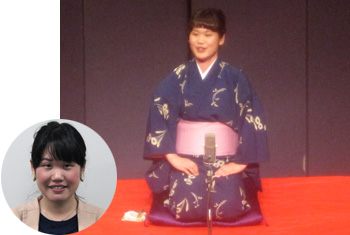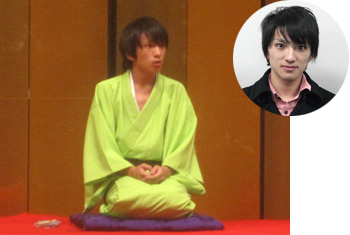Top>HAKUMON Chuo [2014 Early Spring Issue]>[News & Chuo University News] Chuo Rakugo Club Performs in Shizuoka
 Index
Index
News & Chuo University News
Chuo Rakugo Club Performs in Shizuoka
Receiving high recognition
On January 5, the Chuo University Rakugo Club performed at the Spa Theatre held at a public bathhouse in Ito City, Shizuoka Prefecture.
Among all university rakugo clubs, the Chuo Rakugo Club was offered to perform, second to Meiji University which has produced many professional rakugo storytellers.

Juri Furuyama performs on stage
Skilled at telling the stories Rinki-no-Koma, Yadoya-no-Tomi and Yakan-Name
The stage was a roadside station named Seaside Spa. Through cooperation with university rakugo clubs in Tokyo, performances have been held starting from September 2013. Students give the opening performance, followed by the appearance of professional rakugo storytellers.
One day, the Chuo Rakugo Club received an unexpected email inviting them to perform.
The Chuo Rakugo Club is instructed by rakugo master Saiga Katsura, originally a member of the Japan Maritime Self Defense Force, and Utamusashi Sanyutei, who had competed as a sumo wrestler. Also this spring, master Saishi Katsura, who provides instruction to young storytellers, was designated as the first star performer from the Chuo Rakugo Club. These facts made the club well-known to the rakugo society.
All rakugo club members from Chou University went to watch and learn from their instructors’ performance in Tokyo.
At the Seaside Spa, Juri Furuyama (3rd year, Faculty of Economics; former club leader) and Daiki Otoguro (1st year, Faculty of Commerce) performed.
Furuyama had worked part-time at a famous Japanese inn in Ito City during the year-end and New Year holidays. For her, the invitation to perform was perfect timing. Otoguro also gladly accepted the invitation to perform, noting that “I like to go around performing everywhere.”
The crowd of rakugo aficionados was thrilled by Furuyama’s performance of Rinki-no-Koma and Otoguro’s rendition of Tenshiki.
Both Furuyama and Otoguro were born in the Heisei Period. By diligently studying the historical background behind their performances, they succeeded in creating an Edo Period atmosphere of rakugo.

Handsome performer Daiki Otoguro.
Known for his performances of Tenshiki, Chiritotechin and Tengu Sabaki.
Born in the Kansai region, Furuyama has developed an interest in comedy through television ever since she was a child. She enjoyed the Kansai culture of joking even during conversation with friends.
“I really like the Japanese standup comedy manzai,” she says. “Although I entered the rakugo club, I really intended to do manzai.”
However, her authentic experience with rakugo at the Chuo Rakugo Club caused Furuyama to change her mind. She felt that talking in the presence of people would also help her with job-searching activities.
During interviews with companies, Furuyama was often asked about her activities in the Chuo Rakugo Club that she had written on her résumés and application sheets. Interviewers were impressed by her composure and smooth speaking. Her daily practice in rakugo had truly paid off.
Otoguro has practiced rakugo since he studied at Chuo University Suginami High School, finishing runner-up at a national competition.
“Although I watch the rakugo comedy program Shoten (Nippon Television), I’m not so absorbed in rakugo. However I think rakugo really fits me,” explains Otoguro. “Actually, I struggle with stage fright. Sometimes, my hands tremble when I am up on stage holding my fan.” Such a revelation is surprising. “Anyway, the experience of entering university and traveling to perform in front of strangers is sure to help me in the future.”
There is a Japanese proverb that good fortune and happiness will come to the home of those who smile. It seems like the future is bright for Furuyama and Otoguro.
Stage photographs provided by the Chuo University Rakugo Club
- Research Activities as a Member of Research Fellowship for Young Scientists (DC1), Japan Society for the Promotion of Science (JSPS) Shuma Tsurumi
- Important Factors for Innovation in Payment Services Nobuhiko Sugiura
- Beyond the Concepts of Fellow Citizens and Foreigners— To Achieve SDGs Goal 10 “Reduce Inequality Within and Among Countries” Rika Lee
- Diary of Struggles in Cambodia Fumie Fukuoka
- How Can We Measure Learning Ability?
—Analysis of a Competency Self-Assessment Questionnaire— Yu Saito / Yoko Neha - The Making of the Movie Kirakira Megane








